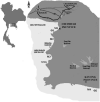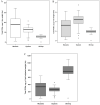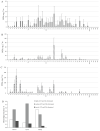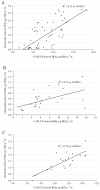PCBs contamination in seafood species at the Eastern Coast of Thailand
- PMID: 19375780
- PMCID: PMC2855220
- DOI: 10.1016/j.chemosphere.2009.03.018
PCBs contamination in seafood species at the Eastern Coast of Thailand
Abstract
Polychlorinated biphenyls (PCBs) are a large group of persistent organic substances spread throughout the world. The most toxic PCBs are those that are dioxin-like (dl-PCBs). Environmental studies on PCBs in Thailand are limited, especially with regards to dl-PCBs. This study is one of the first in this country that demonstrates contamination of seafood with PCBs and determines the levels of PCBs and total dioxin like activity in mussels, oysters and shrimp, from the Eastern Coast of Thailand. Sixty pooled samples of mussels and twenty-seven pooled samples of oysters were collected from cultivation farms and twenty-one pooled samples of shrimp were collected from fisherman piers. Qualitative and quantitative measurements of 49 PCB congeners was obtained by HRGC-ECD analysis and total dioxin-like activity using the CAFLUX bioassay. Total PCB concentrations varied between three species, ranging between 19 and 1100 ng g(-1) lipid adjusted weight, and the levels of PCBs in shrimp was three time higher than that in mussels and oysters. With respected to the pattern of PCB congeners, it implied that the source of PCBs exposure in this area could be from the regional contamination. The calculated CAFLUX bioanalytical equivalents (BEQs) values ranged between 0.8 and 18 pg BEQ g(-1) lipid adjusted weight, and showed a good relationship with the chemical-derived TEQs. Therefore, the CAFLUX bioassay can be used for effective screening of dioxin-like activity in marine species effectively.
Figures





Similar articles
-
Polychlorinated biphenyls (PCBs) in commonly consumed seafood from the coastal area of Bangladesh: occurrence, distribution, and human health implications.Environ Sci Pollut Res Int. 2019 Jan;26(2):1355-1369. doi: 10.1007/s11356-018-3671-x. Epub 2018 Nov 13. Environ Sci Pollut Res Int. 2019. PMID: 30426367
-
Time series data (2008-2023) of polychlorinated dibenzo-p-dioxins, dibenzofurans and polychlorinated biphenyls in bivalves from Shellfish Production Areas of the Basque coast (SE Bay of Biscay).Data Brief. 2023 Oct 31;51:109751. doi: 10.1016/j.dib.2023.109751. eCollection 2023 Dec. Data Brief. 2023. PMID: 38020436 Free PMC article.
-
Pesticide and non-dioxin-like polychlorinated biphenyls (NDL-PCBs) residues in foodstuffs from Ismailia city, Egypt.Food Addit Contam Part B Surveill. 2008;1(1):32-40. doi: 10.1080/19393210802236885. Food Addit Contam Part B Surveill. 2008. PMID: 24784535
-
Shellfish and residual chemical contaminants: hazards, monitoring, and health risk assessment along French coasts.Rev Environ Contam Toxicol. 2011;213:55-111. doi: 10.1007/978-1-4419-9860-6_3. Rev Environ Contam Toxicol. 2011. PMID: 21541848 Review.
-
Concentrations of selected trace metals (Cu, Pb, Zn), organochlorines (PCBs, HCB) and total PAHs in mangrove oysters from the Pacific Coast of Mexico: an overview.Mar Pollut Bull. 2002 Nov;44(11):1303-8. doi: 10.1016/s0025-326x(02)00172-8. Mar Pollut Bull. 2002. PMID: 12523531 Review. No abstract available.
Cited by
-
Edible clay inclusion in the diet of oysters can reduce tissue residues of polychlorinated biphenyls.Toxicol Environ Health Sci. 2020 Dec;12(4):355-361. doi: 10.1007/s13530-020-00058-2. Epub 2020 Jun 3. Toxicol Environ Health Sci. 2020. PMID: 33738241 Free PMC article.
-
The status and distribution of PCBs along the coast of Vietnam.Environ Geochem Health. 2019 Feb;41(1):381-390. doi: 10.1007/s10653-018-0168-y. Epub 2018 Aug 9. Environ Geochem Health. 2019. PMID: 30094588
-
Populus × euramericana Accumulates More Organic Pollutants (PAHs and PCBs), While P. nigra 'Italica' Absorbs More Heavy Metals.Plants (Basel). 2025 May 12;14(10):1445. doi: 10.3390/plants14101445. Plants (Basel). 2025. PMID: 40431010 Free PMC article.
-
Polychlorinated biphenyls (PCBs) in commonly consumed seafood from the coastal area of Bangladesh: occurrence, distribution, and human health implications.Environ Sci Pollut Res Int. 2019 Jan;26(2):1355-1369. doi: 10.1007/s11356-018-3671-x. Epub 2018 Nov 13. Environ Sci Pollut Res Int. 2019. PMID: 30426367
References
-
- Baars AJ, Bakker MI, Baumann RA, Boon PE, Freijer JI, Hoogenboom LA, Hoogerbrugge R, van Klaveren JD, Liem AK, Traag WA, de Vries J. Dioxins, dioxin-like PCBs and non-dioxin-like PCBs in foodstuffs: occurrence and dietary intake in The Netherlands. Toxicol. Lett. 2004;151:51–61. - PubMed
-
- Bocio A, Domingo JL. Daily intake of polychlorinated dibenzo-p-dioxins/polychlorinated dibenzofurans (PCDD/PCDFs) in foodstuffs consumed in Tarragona, Spain: a review of recent studies (2001–2003) on human PCDD/PCDF exposure through the diet. Environ. Res. 2005;97:1–9. - PubMed
-
- Borga K, Gabrielsen GW, Skaare JU. Biomagnification of organochlorines along a Barents Sea food chain. Environ. Pollut. 2001;113:187–198. - PubMed
-
- Charnley G, Doull J. Human exposure to dioxins from food, 1999–2002. Food Chem. Toxicol. 2005;43:671–679. - PubMed
-
- de Boer J. Trends in chlorobiphenyl contents in livers of Atlantic COD (Gadus Morhua) from the North Sea, 1979–1987. Chemosphere. 1988;17:1811–1819.
Publication types
MeSH terms
Substances
Grants and funding
LinkOut - more resources
Full Text Sources
Medical

